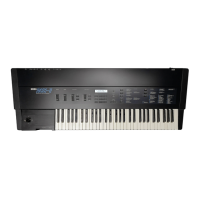GENERAL OPERATION
■ When you use the program change function, you are
replacing the program output buffer memory con
tents with a program from program memory. The
data is simply copied from program memory to the
buffer. The data previously in the buffer is erase. If
you make changes to the current program and do not
want to loose those changes, then you must write the
changed data back to the program memory before
calling another program. (F01 write/rename),
■ In this mode you can initialize the parameters so that
the VGA, VCF, delay, and other sections of the syn
thesizer will not have any effect on the sound. (Use
F00 initialize parameters).
If you will be working on a multisound in another
mode, please initialize the program parameters
beforehand.
PROGRAM OUTPUT SUFFER
16] System Mode
■ System mode functions
This mode lets you handle programs and multi
sounds as complete systems. You can edit systems,
write them to disk and get (load) them from disk to
memory.
■ The system mode offers the following facilities for
editing program memory and wave memory,
• Directory of program names in program
memory.
• Directory of multisound names and lengths in
wave memory, with indication of free space.
• Loading of all (32) programs from a system on
disk.
• Loading of a single program from disk.
• Loading of a single multisound from disk.
• Deletion of multisounds from wave memory.
Other system save and load functions include the
following: •
• You can save all programs in program memory
to a specific system on disk. (Effective when
changing only the program parameters.)
• You can save a whole system to disk, including
all of its programs, multisounds and MIDI
parameters.
• You can load a whole system from disk, in
cluding its programs, multisounds, and MIDI
parameters.
Initial display for system mode.
58

